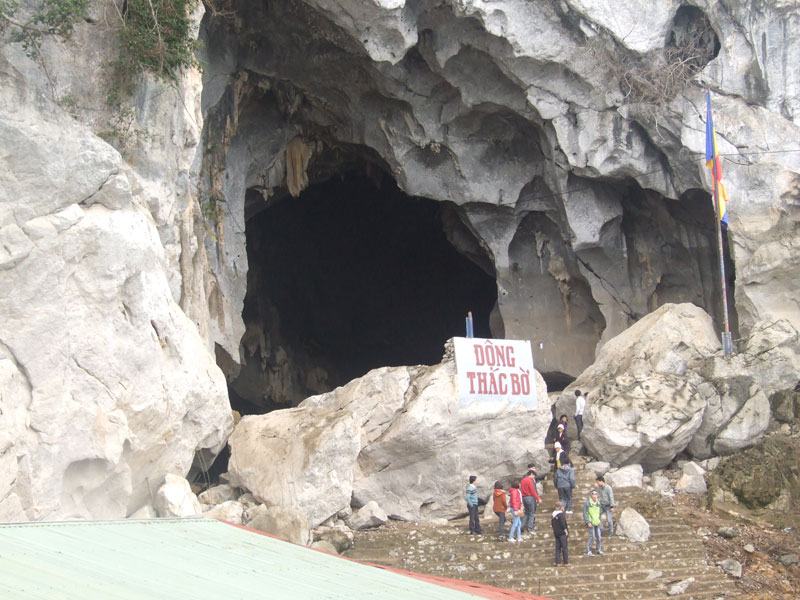



Tourists visiting Thac Bo Cave.
It is quite convenient to travel to Thac Bo Cave from the
Highway 6. You can follow the road Binh Thanh - Thung Nai, and then go about 20
minutes waterway or you can leave from Bich Ha pier in Thai Thinh commune and
travel to in about 1 hour by boat.
Thac Bo Cave is located in Ngoc pier in the northern slope,
on the bank of Da River. Bo waterfall was once called Van Bo waterfall, which
was created by hundreds of large and small cliffs undulating like a huge
elephant group in the middle of Da River. It has a legend that the temple
worships Bo Waterfall Princess of Dinh Thi Van - a Muong person, who helped Le
Loi King manage the food and boats for the military force to overcome Bo
waterfall and cross to Muong Le, Son La to pacify Cat Han Pass Party. After shedied,
she usually made her
epiphany to help people overcome the waterfall safely and bless hundreds of
people in the area with favorable weather and climate. People living in the
area set up a temple to worship her. Bo waterfall temple once belonged to Hao
Trang commune, and after a lot of changes about administrative boundaries, it
is now located between Thung Nai commune, Cao Phong district and Vay Nua
commune, Da Bac district, Hoa Binh province.
On the journey of visiting and worshipping the temple of Bo
waterfall princess, tourists will continue to exploit the Thac Bo Cave in the
natural charming scene of Hoa Binh Lake. In the dry season, tourists who want
to visit the cave have to go trekking about 100 stone steps from the foot of the
mountain to the cave entrance. In the flooding season, visitors have to move
from the boat to the floating house which is built on a bamboo raft, which runs
about 50 meters to the cave entrance. From the entrance, tourists can overlook
to feel majestic and romantic about the mountain and forest, as well as exploit
the beauty of the mysterious cave.
The cave is divided into three areas, the first one is outside
the bottom of the cave, there are many stalactites in the tourist reception,
and then the Buddha Worship place which is higher about 5 meters. The arc cave
area is quite large with fresh air. Besides the large altar worshipping the
great Bodhisattva Buddha, the Bodhisattva Avalokiteshvara and the gods
administer this area. The inside of the cave is composed of various stalactites
by lime crust dropping droplets in millions of years, which shows the endless
creativity of the majestic nature. The different shapes of the stalactites are
like dragon carp, golden trees, silver trees, the sky, stone piano, Muong gong
set to become a holy song of the sky piano.
In addition, you can visit some tourist destinations near
Trach River, the island and guesthouse of Windmill, Bo market which is held
every Sunday morning, Ngoi Hoa hamlet and cave, fish cages on the lake. You can
also understand the culture, living customs, production and the life of local
people through rowing, fishing, cooking, tasting the special smell of different
grilled fish, Da river fish and mountainous specialties such as steamed chicken
with lemon leaves, local pork grilled with honey on banana leaf, boiled bamboo
shoots, special rice, wild apple wine, wild vegetables with fish sauce. All of
these will make unforgettable impression after the journey to explore Thac Bo
Cave of Da River Lake.